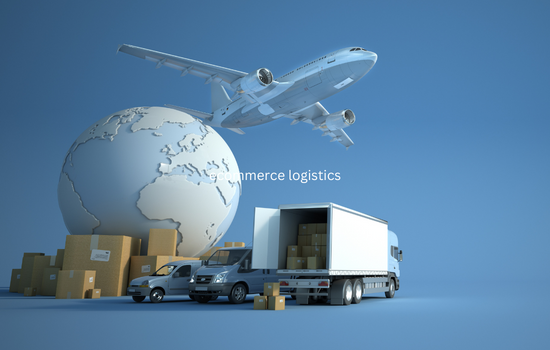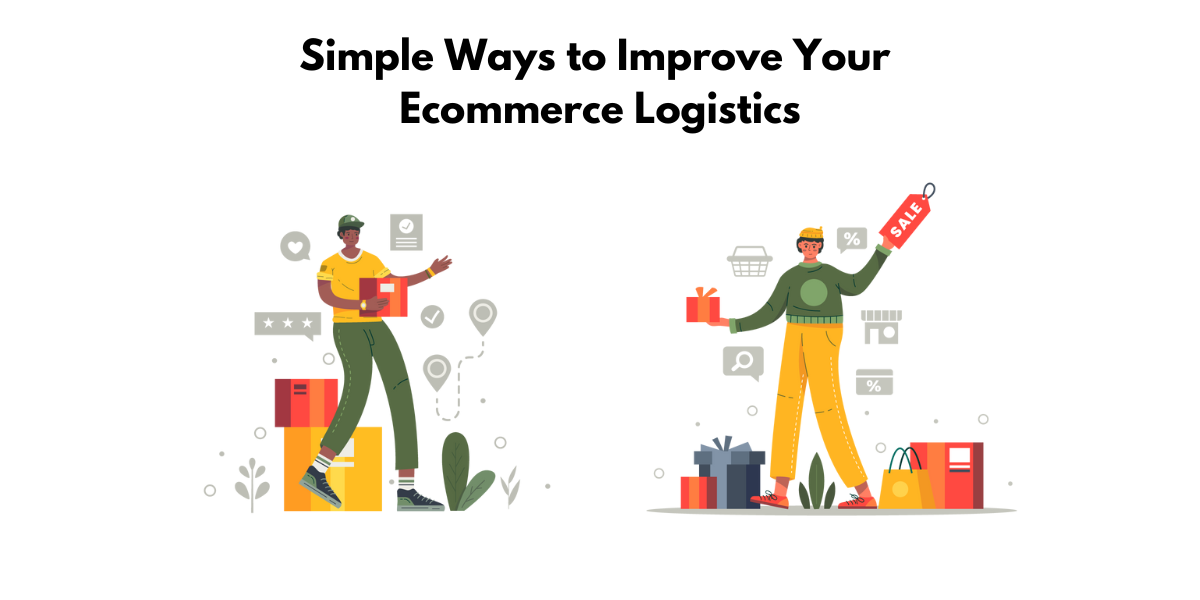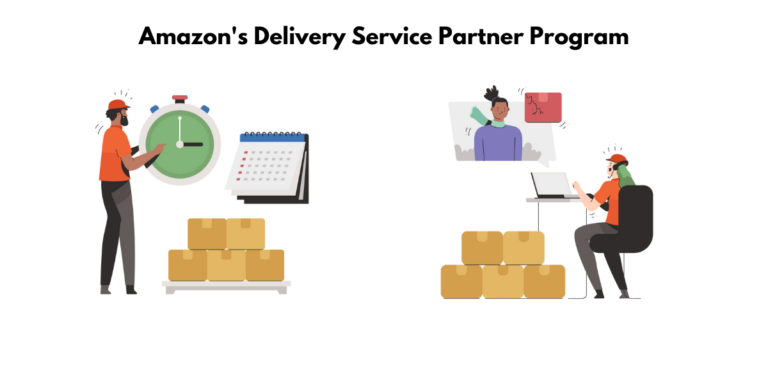Ecommerce Logistics: The what, why, and how to optimize your supply chain
The what, why, and how of ecommerce logistics
Ecommerce logistics can be a complex and daunting task for even the most experienced business owners. There are many moving parts; if anyone is not working efficiently, it can have a ripple effect that throws off your entire operation.
Fortunately, there are some steps you can take to streamline your ecommerce logistics and ensure your supply chain is running smoothly. In this blog post, we’ll cover the what, why, and how of e commerce logistics market so you can optimize your operation for success.

What is ecommerce logistics?
Ecommerce logistics manages the storage, transportation, and delivery of goods purchased online. Ecommerce logistics can be complex and costly, but there are ways to optimize your visible supply chain and minimize expenses.
What is ecommerce logistics? In a nutshell, it manages to store, transport, and deliver goods purchased online. Ecommerce logistics can be complex and costly, but there are ways to optimize your supply chain and minimize expenses.
Why is ecommerce logistics important? Because an efficient and cost-effective supply chain is essential to the success of any online business. A recent study by Forrester Research found that 43% of ecommerce executives believe that logistics is a key differentiator in the marketplace.
How does a logistics company work?
Ecommerce logistics is managing the transportation and storage of goods for online businesses. It includes everything from order fulfilment and warehousing to shipping and delivery. A good ecommerce logistics company will have a well-developed infrastructure and process to ensure that orders are fulfilled efficiently and delivered on time.
Why is good ecommerce logistics important?
You have a great ecommerce business idea. You’ve researched, know what your customers want, and are ready to sell. But there’s one more important piece of the puzzle: logistics.
Good ecommerce logistics are essential for any online business that wants to be successful. Here’s why:

Faster shipping and delivery
Faster shipping and delivery can help good ecommerce logistics by providing options such as same-day delivery, free shipping, or shipping discounts. It can also increase customer satisfaction by ensuring the timely delivery of products.
By providing faster shipping options, ecommerce businesses can attract more customers and increase sales. Additionally, offering competitive shipping rates for products that are available elsewhere helps to stand out from the competition while reducing costs. Finally, providing customers with a reliable time frame for when their orders will be delivered encourages them to shop with you again since they know when to expect their package to arrive.
Improved customer satisfaction
Improved customer satisfaction can lead to positive effects on ecommerce logistics, such as reducing returns and negative reviews, improving products and marketing strategies, and reducing the return rate.
By investing resources to understand customers’ problems and claims, businesses can improve their products or services to achieve greater customer satisfaction, leading to increased sales or reduced transportation costs. Additionally, providing quick customer support services can reduce the number of reverse logistics or negative reviews.
Increased sales due to a faster checkout process
The faster checkout process allows ecommerce businesses to cater to their customer’s needs at the checkout, increasing sales.
Studies indicate that 7/10 customers leave the checkout once their payment information needs to be entered. Optimizing the shipping process allows businesses to reduce this number and improve conversions.
Reduced costs due to optimized warehouse and shipping processes
Optimizing warehouse and shipping processes can help to reduce costs for good ecommerce logistics. This is because it allows for more efficient distribution solutions, such as reduced incidents, faster delivery times, and cost-effective strategies.
As a result, businesses can offer better services and products at a lower cost while improving customer satisfaction with faster deliveries.
Increased efficiency due to the automation of logistics processes
Using an eCommerce logistics solution can improve efficiency by reducing the number of incidents, improving delivery times, and allowing for better logistics process management.
This will allow businesses to offer better services and products at a lower cost while providing customers with a better experience. Automating logistics processes can also help reduce manual tasks and save valuable time for employees who would otherwise be spending their time on these tasks.
Improved customer experience due to better warehouse and inventory management
Good ecommerce logistics can improve customer experience by allowing businesses to offer better services and products at a lower cost. This is possible thanks to efficient incident management, faster delivery times, and better warehousing and distribution processes.
The improved customer experience resulting from good ecommerce logistics includes reduced incidents, faster delivery times, and better quality of products or services offered. This creates a positive perception of the online shop in customers’ eyes.
Ability to scale up quickly with increased ecommerce sales
Good ecommerce logistics can help to scale up quickly with increased sales by providing a scalable logistics network that can keep up with demand. It also allows businesses to focus on their core business while leaving the fulfillment process in the hands of experts. Additionally, ecommerce businesses can benefit from ShipBob’s technology which automates many tasks, such as order tracking and customer communication. This helps reduce operational costs while ensuring orders are processed quickly and accurately.
Improved customer experience due to faster order fulfillment
Fast order fulfillment can improve the customer experience by allowing businesses to deliver products faster. This allows customers to receive their orders sooner, increasing their satisfaction with the ecommerce store.
The faster the order fulfillment, the better customers view your online shop. It also allows businesses to compete with rivals by offering faster delivery times that may be important for certain products or locations. Additionally, machine learning and artificial intelligence can optimize order fulfillment processes and reduce inefficiencies, resulting in more efficient order processing and faster turnaround times for orders.
Reduced returns and customer complaints due to accurate orders
Accurate order fulfillment reduces returns and customer complaints by ensuring that the products customers receive are as expected.
Reduced returns and customer complaints mean greater customer satisfaction, loyalty, and brand trust. This can lead to increased sales and a better reputation for your brand.
Improved efficiency due to better communication and collaboration between teams
Improved efficiency can result from better communication and collaboration between ecommerce teams due to reduced incidents, faster processing of orders, and improved document management.
This allows for a better understanding of customer needs, better quality control over products and services offered, timely response to customer queries or complaints, and quicker resolution of issues if they arise. Furthermore, it helps reduce inefficiencies in logistics operations, such as shipping times and costs.

Components of an optimal e-commerce logistics setup
E-commerce logistics is a process that involves the transportation and storage of goods purchased online. This type of logistics differs from traditional brick-and-mortar businesses because it often requires special handling to ensure that products are delivered safely and on time.
To run an effective e-commerce business, you must have a well-oiled logistics machine. In this post, we’ll break down the components of an optimal e-commerce logistics set up so you can make sure your business is running smoothly.
Warehousing
Warehousing plays an important role in an optimal e-commerce logistics setup. It provides a cost-efficient solution for customer distribution by reducing shipping costs and increasing speed. Strategic warehousing locations combined with best-in-class design tools, processes, and systems ensure the effective distribution of products to customers. Warehouses can also provide valuable data insights that help optimize the customer experience and increase sales conversions. Additionally, they can provide fulfillment services such as order picking, packaging, labeling, and shipping services which reduce customer wait times.
Shipping
To optimize your ecommerce logistics setup, it is important to understand the various components involved. Shipping is one of the most critical aspects of ecommerce logistics, and there are a few key things to remember when planning your shipping strategy.
First, you must ensure that your products are properly packaged and protected for shipping. This means using the appropriate packaging materials and ensuring that your products are securely wrapped and cushioned to avoid damage during transit.
You also need to choose the right shipping carrier for your needs. There are a variety of carriers out there, each with its strengths and weaknesses. Do some research to find the carrier that best fits your needs in terms of price, service, and delivery times.
Finally, you must ensure that your shipping process is as efficient as possible. This means having a system to track orders and shipments and ensuring that your products are shipped out promptly.
By following these tips, you can optimize your ecommerce shipping process and ensure that your customers are happy with their purchases.
Ecommerce platform
An ecommerce platform plays an essential role in an optimal e-commerce logistics setup. It provides a centralized platform where merchants can list their products, manage orders and customer relationships, track shipments, and more. This allows the e-commerce company to focus on delivering top-quality customer service while leaving the logistics operations to experts. The platform also enables businesses to gain valuable insights into their customers’ preferences and buying habits, which can be used to improve their product offerings or delivery services. Furthermore, it provides a single point of access for all related services, such as payment processing and logistics tracking – making it easier for merchants to manage their operations without getting involved in complex logistical processes.
Inventory management
Inventory management is keeping track of all an organization’s products, location, quantity, and status. It involves knowing which warehouse(s) contain SKUs (stock-keeping units) and tracking shipments between locations. It also involves knowing which SKUs are running low on and when to reorder them next.
Inventory management is important for an optimal e-commerce logistics setup because it helps businesses manage their resources effectively by ensuring that products are available when needed. It also allows companies to track inventory costs over time to make better decisions about when to reorder items or adjust prices accordingly. Additionally, effective inventory management can help businesses avoid costly mistakes such as overselling items or running out of stock unexpectedly due to inaccurate tracking systems.
Warehousing management system
An optimal e-commerce logistics setup is one in which the seller manages all components of ecommerce logistics themselves, from warehousing to shipping.
A warehouse management system (WMS) is a software tool that tracks warehouse performance and provides valuable insights for improving processes. It can help with tracking inventory levels, picking and packing operations, calculating shipping costs, and automating logistical tasks. A good ecommerce 3PL will have its own WMS that feeds insights directly to the merchant so they can make more informed decisions about optimizing their operations.
Supply chain
The e commerce supply chain is a critical component of any ecommerce business. It includes all the steps involved in getting products from suppliers to customers, including manufacturing, warehousing, shipping, and order fulfillment. An efficient and effective supply chain ensures that customers receive their orders on time and in good condition.
Ecommerce logistics processes
In ecommerce logistics, the processes involved in storing and shipping inventory for an online store or marketplace include inventory management, pricing, packing, and shipping of orders. The process starts with getting inventory from the manufacturer or supplier and ends with delivering the product to customers’ doorsteps. To ensure the smooth operation of these processes, it is important to have a system that tracks every order from start to finish. This helps businesses track their shipments efficiently and ensures the timely delivery of goods to customers.
Retail network
An e-commerce retail network is a group of retailers that provide access to their stores to sell products online. It is an important component of an optimal logistics setup because it allows retailers to reach more customers and expand their reach beyond traditional brick-and-mortar stores.
A retail e-commerce network allows retailers to sell their products in more locations, reaching more potential customers than they would be able to otherwise. Additionally, it allows them to compete with larger companies by expanding their market reach without building additional warehouses or physical stores across the country or globe. By partnering with other retailers in the network, smaller businesses can also benefit from economies of scale, such as reduced shipping costs and increased customer loyalty due to shared branding efforts between partners in the network.
Order fulfillment
Order fulfillment is the final stage of the order management process, where products are packaged and prepared for delivery. It is important because it helps ensure that customers receive their orders on time.
Optimal e-commerce logistics setups should consider order fulfillment as a priority, as it can significantly impact customer satisfaction. Fast and efficient order fulfillment will help ensure that deliveries are made on time, resulting in fewer customer complaints and a better brand reputation overall. Additionally, an optimized system can save time and money by reducing inventory misplacements or errors during packaging processes.
Logistics partner
A logistics partner is a company that provides various logistics services, such as distribution, warehousing, transportation, and shipping.
The role of a logistics partner in an optimal e-commerce setup is to manage all the aspects of the logistics chain from end to end. They can help reduce costs by optimizing processes and improving efficiency to ensure faster delivery times for customers. Logistic companies now specialize in certain areas of the chain, so it’s important to identify which type is right for your business needs.

FAQs
Here are some of the most frequently asked questions about commerce logistics:
Is Amazon a logistics company?
Yes, Amazon is a logistics company. Under normal circumstances, the company can make deliveries to customers within 24 to 48 hours through its Prime Delivery label. Recent technologies such as advanced robotics, augmented reality, and drones are helping companies stay competitive and reduce operational costs to meet customer demand. Additionally, investing in distribution centers and warehouses helps speed up the design, development, and implementation of logistics processes for modern e-commerce channels. Therefore, Amazon is a logistics company as it provides services that facilitate the movement of goods from one location to another with efficiency and speed.
Is USPS a logistics company?
Yes, USPS is a logistics company. They offer a wide range of services and tools to help their clients manage freight and logistics. USPS can alert customers when it has to increase or decrease costs due to economic circumstances or business changes, provide custom services and coordinate with business connections. Additionally, they can help optimize product packaging by considering materials used, automation processes vs. labor-intensive methods, and outsourcing options. Furthermore, USPS offers to track information for packing shipping so businesses can stay informed about where their packages are at all times. Finally, USPS supports ePacket shipping in countries around the world, making it easier for online retailers to send packages internationally at lower rates than normal airmail rates.
What is a distribution channel in business, and how does it work?
A distribution channel is a method businesses use to distribute products or services. It can involve one or multiple steps, such as storing inventory at a warehouse, packaging it for shipment, and delivering it to customers.
The purpose of distribution channels is to increase efficiency and reach more customers. By splitting inventory between different warehouses or modes of transport, companies can reduce shipping costs while still providing fast delivery times. Additionally, they may choose separate warehouses for B2B (business-to-business) and DTC (direct-to-consumer) orders because they require different packaging or shipping destinations.
How do ecommerce logistics trends affect your ecommerce business?
Logistics trends can have a significant impact on your ecommerce business. Rapidly evolving technologies and shifting consumer expectations are driving changes in the logistics industry, which can impact your eCommerce supply chain.
These changes could lead to improved customer experience, faster delivery times, better efficiency in shipping processes, and reduced costs – all of which would benefit your eCommerce business. Alternatively, suppose you fail to keep up with these trends or implement an effective logistics strategy. In that case, it could negatively impact your business by leading to breakdowns in the shipping process or slow delivery times that disappoint customers.
What is the impact of the pandemic on ecommerce logistics?
The COVID-19 pandemic caused widespread supply chain shortages that impacted ecommerce businesses.
As a result, some ecommerce businesses experienced an increase in orders while others saw a decrease in sales. Businesses had to be creative and think outside the box to adapt to these changing circumstances, such as offering “hoarding” opportunities, messaging about the pandemic and supply chain shortages, diversifying manufacturing and fulfillment locations when possible, providing Amazon Prime-like customer experiences with ShipBob’s fulfillment centers without inflating shipping costs.
- Ecommerce Logistics: The what, why, and how to optimize your supply chain - January 30, 2023


